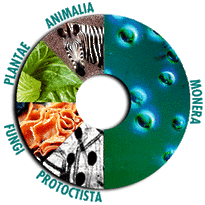Name: Vanessa Awando
Class: SL Biology C
Date: 22/02/2016
Page Title
7 Levels


7 Levels
Images - http://www.softschools.com/science/biology/classification_of_living_things/ Web. 28 Feb, 2016
The different Kingdoms
All organisms can be classified at 7 different levels these include - kingdom, phylum, class, order, family, genus and species. Every level contains organisms with similar characteristics.
Kingdom
Initially all living things were placed into two kingdoms, known as plants and animals.Then animal kingdom included every living thing that was mobile, ate, and grew
to a certain size and stopped growing. Plants included every living thing that did not move or eat and that continued to grow throughout life. Eventually it became very difficult to group some living things into one or the other, so in the past century the two known kingdoms were expanded into six kingdoms: Protista (the single-celled eukaryotes); Fungi (fungus and related organisms); Plantae (the plants); Animalia (the animals); Eubacteria and Archaebacteria.This makes the Kingdom the largest/broadest level because all organisms fall into one of the six sub-categories.
Phylum
Phylum is the second level of classification and in this section organisms that have similar distinctive traits in terms of structure are placed together Each of the six kingdoms has it’s own phyla. Some examples of these phyla are - Phylum Chordata, Porifera, Insecta etc. Approximately there are 35 animal and 6 fungal, but botanical term 'division' is the same as 'phylum', so there are also 11 plant, 29 bacterial and 5 archaeal phyla.
Class
All organisms that fall under a specific phylum are further categorized into another taxonomic rank known as classes. These classes are based on important, more detailed, similarities. Many times the classification of organisms into classes, is based on observation of the organisms. There is no scientific method in organizing living things in this manner. For this reason, the number of classes, or any level of classification, could change at any moment.Examples of some classes include - Amphibians, Mammals and Reptiles. These are based on the observation of animals such as snakes, whales and frogs. For example frogs are amphibians because they are cold blooded and most live in water.
Order
To determine the order of an organism a taxonomy key is read. This taxonomy key is used as a checklists and contains characteristics that organisms in a certain class share with other organisms in the same class. Meaning that if organisms share certain key characteristics, then they are placed in the same order. An example is that humans are in the Animal Kingdom, the Chordata Phylum, and the Mammal Class. Our order is - Primates. We are a part of this order because we have an opposable thumb (allow the fingers/thumbs to grasp and handle objects and are characteristic of primates)., are highly intelligent, and have a strong bond between mothers and babies. Other mammals in this order share these characteristics with humans.
Family
Organisms that are placed in an order are then placed under a more specific taxonomic rank known as a family Families are groups of organisms that share certain adaptive traits. Organisms that are placed in the same family are shared to have a common ancestry. Families are groups of organisms that share certain adaptive traits. An example within the humans, who are a part of the animal kingdom, they are then included in the Hominidae Family and they share this with other animals such as chimpanzees, gorillas and orangutans because they share the same characteristics which include - long legs, and canine teeth used to tear meat.
Genus
Organisms in a specific family are further then divide into a genus. There are several genera for the different families but each genera only has a few members because it is a more specific taxonomic rank that shows the group of organisms that share a lot of both external and internal similarities. For example humans belong to the genus Homo but we are the only surviving members of this genus. All other members, such as the Neanderthals, are now extinct.
Species
Species is the specific name given to the organism. Human fall under the sapien species and their scientific name is Homo sapien (a mixture of the genus and species) The main characteristic for an organism to be placed in a specific species is it’s ability to interbreed with other organisms of the same species. because all organisms of a particular species can reproduce with each other. Organisms of a species may have varying appearances but they are the same when it comes to number of cells, functionality, abilities, and reproduction.
O'Niel, Dennis. "Classification of Living Things: Introduction." Classification of Living Things:
Introduction. 2012. Web. 24 Feb. 2016. <http://anthro.palomar.edu/animal/animal_1.htm>.
